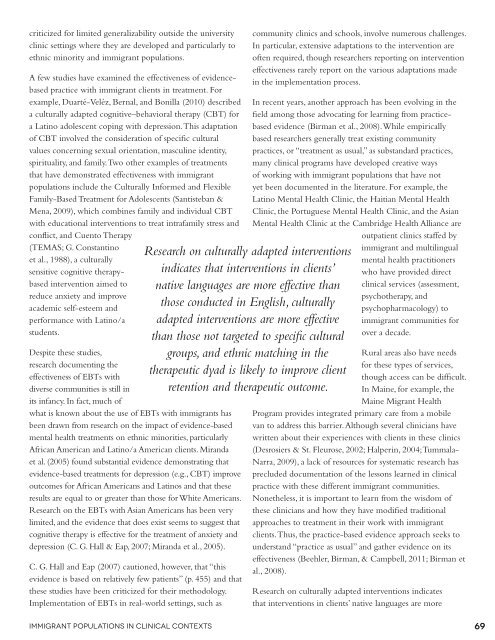Crossroads: The Psychology of Immigration in the New Century
Crossroads: The Psychology of Immigration in the New Century
Crossroads: The Psychology of Immigration in the New Century
Create successful ePaper yourself
Turn your PDF publications into a flip-book with our unique Google optimized e-Paper software.
criticized for limited generalizability outside <strong>the</strong> university<br />
cl<strong>in</strong>ic sett<strong>in</strong>gs where <strong>the</strong>y are developed and particularly to<br />
ethnic m<strong>in</strong>ority and immigrant populations.<br />
A few studies have exam<strong>in</strong>ed <strong>the</strong> effectiveness <strong>of</strong> evidencebased<br />
practice with immigrant clients <strong>in</strong> treatment. For<br />
example, Duarté-Veléz, Bernal, and Bonilla (2010) described<br />
a culturally adapted cognitive–behavioral <strong>the</strong>rapy (CBT) for<br />
a Lat<strong>in</strong>o adolescent cop<strong>in</strong>g with depression. This adaptation<br />
<strong>of</strong> CBT <strong>in</strong>volved <strong>the</strong> consideration <strong>of</strong> specific cultural<br />
values concern<strong>in</strong>g sexual orientation, mascul<strong>in</strong>e identity,<br />
spirituality, and family. Two o<strong>the</strong>r examples <strong>of</strong> treatments<br />
that have demonstrated effectiveness with immigrant<br />
populations <strong>in</strong>clude <strong>the</strong> Culturally Informed and Flexible<br />
Family-Based Treatment for Adolescents (Santisteban &<br />
Mena, 2009), which comb<strong>in</strong>es family and <strong>in</strong>dividual CBT<br />
with educational <strong>in</strong>terventions to treat <strong>in</strong>trafamily stress and<br />
conflict, and Cuento <strong>The</strong>rapy<br />
(TEMAS; G. Constant<strong>in</strong>o<br />
et al., 1988), a culturally<br />
sensitive cognitive <strong>the</strong>rapybased<br />
<strong>in</strong>tervention aimed to<br />
reduce anxiety and improve<br />
academic self-esteem and<br />
performance with Lat<strong>in</strong>o/a<br />
students.<br />
Despite <strong>the</strong>se studies,<br />
research document<strong>in</strong>g <strong>the</strong><br />
effectiveness <strong>of</strong> EBTs with<br />
diverse communities is still <strong>in</strong><br />
its <strong>in</strong>fancy. In fact, much <strong>of</strong><br />
what is known about <strong>the</strong> use <strong>of</strong> EBTs with immigrants has<br />
been drawn from research on <strong>the</strong> impact <strong>of</strong> evidence-based<br />
mental health treatments on ethnic m<strong>in</strong>orities, particularly<br />
African American and Lat<strong>in</strong>o/a American clients. Miranda<br />
et al. (2005) found substantial evidence demonstrat<strong>in</strong>g that<br />
evidence-based treatments for depression (e.g., CBT) improve<br />
outcomes for African Americans and Lat<strong>in</strong>os and that <strong>the</strong>se<br />
results are equal to or greater than those for White Americans.<br />
Research on <strong>the</strong> EBTs with Asian Americans has been very<br />
limited, and <strong>the</strong> evidence that does exist seems to suggest that<br />
cognitive <strong>the</strong>rapy is effective for <strong>the</strong> treatment <strong>of</strong> anxiety and<br />
depression (C. G. Hall & Eap, 2007; Miranda et al., 2005).<br />
C. G. Hall and Eap (2007) cautioned, however, that “this<br />
evidence is based on relatively few patients” (p. 455) and that<br />
<strong>the</strong>se studies have been criticized for <strong>the</strong>ir methodology.<br />
Implementation <strong>of</strong> EBTs <strong>in</strong> real-world sett<strong>in</strong>gs, such as<br />
Immigrant Populations <strong>in</strong> Cl<strong>in</strong>ical Contexts<br />
Research on culturally adapted <strong>in</strong>terventions<br />
<strong>in</strong>dicates that <strong>in</strong>terventions <strong>in</strong> clients’<br />
native languages are more effective than<br />
those conducted <strong>in</strong> English, culturally<br />
adapted <strong>in</strong>terventions are more effective<br />
than those not targeted to specific cultural<br />
groups, and ethnic match<strong>in</strong>g <strong>in</strong> <strong>the</strong><br />
<strong>the</strong>rapeutic dyad is likely to improve client<br />
retention and <strong>the</strong>rapeutic outcome.<br />
community cl<strong>in</strong>ics and schools, <strong>in</strong>volve numerous challenges.<br />
In particular, extensive adaptations to <strong>the</strong> <strong>in</strong>tervention are<br />
<strong>of</strong>ten required, though researchers report<strong>in</strong>g on <strong>in</strong>tervention<br />
effectiveness rarely report on <strong>the</strong> various adaptations made<br />
<strong>in</strong> <strong>the</strong> implementation process.<br />
In recent years, ano<strong>the</strong>r approach has been evolv<strong>in</strong>g <strong>in</strong> <strong>the</strong><br />
field among those advocat<strong>in</strong>g for learn<strong>in</strong>g from practicebased<br />
evidence (Birman et al., 2008). While empirically<br />
based researchers generally treat exist<strong>in</strong>g community<br />
practices, or “treatment as usual,” as substandard practices,<br />
many cl<strong>in</strong>ical programs have developed creative ways<br />
<strong>of</strong> work<strong>in</strong>g with immigrant populations that have not<br />
yet been documented <strong>in</strong> <strong>the</strong> literature. For example, <strong>the</strong><br />
Lat<strong>in</strong>o Mental Health Cl<strong>in</strong>ic, <strong>the</strong> Haitian Mental Health<br />
Cl<strong>in</strong>ic, <strong>the</strong> Portuguese Mental Health Cl<strong>in</strong>ic, and <strong>the</strong> Asian<br />
Mental Health Cl<strong>in</strong>ic at <strong>the</strong> Cambridge Health Alliance are<br />
outpatient cl<strong>in</strong>ics staffed by<br />
immigrant and multil<strong>in</strong>gual<br />
mental health practitioners<br />
who have provided direct<br />
cl<strong>in</strong>ical services (assessment,<br />
psycho<strong>the</strong>rapy, and<br />
psychopharmacology) to<br />
immigrant communities for<br />
over a decade.<br />
Rural areas also have needs<br />
for <strong>the</strong>se types <strong>of</strong> services,<br />
though access can be difficult.<br />
In Ma<strong>in</strong>e, for example, <strong>the</strong><br />
Ma<strong>in</strong>e Migrant Health<br />
Program provides <strong>in</strong>tegrated primary care from a mobile<br />
van to address this barrier. Although several cl<strong>in</strong>icians have<br />
written about <strong>the</strong>ir experiences with clients <strong>in</strong> <strong>the</strong>se cl<strong>in</strong>ics<br />
(Desrosiers & St. Fleurose, 2002; Halper<strong>in</strong>, 2004; Tummala-<br />
Narra, 2009), a lack <strong>of</strong> resources for systematic research has<br />
precluded documentation <strong>of</strong> <strong>the</strong> lessons learned <strong>in</strong> cl<strong>in</strong>ical<br />
practice with <strong>the</strong>se different immigrant communities.<br />
None<strong>the</strong>less, it is important to learn from <strong>the</strong> wisdom <strong>of</strong><br />
<strong>the</strong>se cl<strong>in</strong>icians and how <strong>the</strong>y have modified traditional<br />
approaches to treatment <strong>in</strong> <strong>the</strong>ir work with immigrant<br />
clients. Thus, <strong>the</strong> practice-based evidence approach seeks to<br />
understand “practice as usual” and ga<strong>the</strong>r evidence on its<br />
effectiveness (Beehler, Birman, & Campbell, 2011; Birman et<br />
al., 2008).<br />
Research on culturally adapted <strong>in</strong>terventions <strong>in</strong>dicates<br />
that <strong>in</strong>terventions <strong>in</strong> clients’ native languages are more<br />
69
















